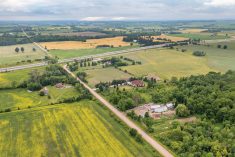In my previous article for Grainews, I explained how team building is important on farms in today’s complex agricultural environment. It’s vital all members of the team have input into the overall farm business plan and have at least some of their individual needs met.
A team with a common understanding of the intent and direction of the business will have a much better chance of achieving its combined objectives. Once all of the team members are around a table and conversing harmoniously, it’s time to get down to business. One of the first items to focus on should be the farm business plan.
Read Also

Cover crops seeded with wheat show no yield penalty in Manitoba trials
Research at Manitoba Diversification Centres shows farmers can seed legumes with spring wheat to establish cover crops without hurting yield, even in dry years.
A farm business plan consists of three main parts:
- A history of the farm — when and who started it and how it grew over the years.
- The present status of the farm — the size, the enterprises (grains and oilseeds, cow-calf, etc.), the people involved and their responsibilities and financial details.
- The goals of the team members and their combined objectives for the farm in the short term (one to five years) and the long term (10-plus years).
As implied above, the farm business plan should be an extension of the goals and aspirations of the individual team members. Once each person feels their own goals are being met (to some degree) they are much more likely to become motivated team members who will help drive the farm to its overall goals. They will also feel they have some “skin in the game” and are responsible for achieving the stated objectives. In the last issue, I likened the farm team to a team of horses pulling a plow, where each member was pulling hard to achieve the objectives.
Preparing a business plan is especially important before changing some part of the operation, such as buying more land, diversifying, adding a new enterprise (e.g. a cow-calf component) or buying new(er) machinery. As the saying goes, “guys love their iron,” and sometimes they just can’t resist the shiny new units on a dealer’s lot. I’ve had to help many farmers who expanded their land base or bought new machinery and did not do the necessary financial projections before buying. Subsequently, they encountered cash flow difficulties when they could not meet their loan payments on time.
When preparing a business plan, your whole family or team should be involved to gain their input and support. Remember, they are all a vital part of your operation and must be on side as part of the functioning team. The business plan will involve much more than just the financial aspects (outlined below). Some of the overlooked items are doing due diligence (background information) acquiring new knowledge (if necessary), looking for possible new challenges and finding solutions for them and any possible risk management issues.
Cash flow
We’ve all heard the phrase “cash is king.” It will be important for you to look at cash flow for your operation before making any changes to determine if you can make additional financial commitments on time. There are programs that can help with this; for example, I have one called the Agricultural Business Analyzer (ABA), which is a month-by-month cash flow projection to determine if you can work within your operating loan limit and/or trade credit. Remember to include adequate money for family living expenses in your projections. I recommend at least $50,000 per year (about $4,166 per month).
Lenders also like to see sensitivity analyses, which means running your base scenario with 10 per cent lower market prices, 10 per cent higher input costs and a third analysis with both combined. Can you achieve at least a 1.2:1 debt servicing ratio with all of these scenarios, and preferably a 1.5:1 ratio?
If you’re going to require financing, remember you don’t get a second chance to make a first impression with your lender, so make it a good one with a detailed business plan. The lender will be more likely to view your request favourably if you present them with a detailed plan and they will also be more ready to negotiate rates and terms.
The business plan outline I use is as follows:
- Executive summary
- Background and purpose
- Strategic plan
- Goals — both personal (for each member) and business (for the whole farm)
- Option(s) to achieve goals
- Action plan — option chosen, implementation plan, steps and dates
- Marketing plan
- Risk management plan
- Financial highlights — selected data from ABA program (before and after scenarios)
- Closing comments (about overall viability)
- Professional advisors
Review the year, revisit the plan
After you have completed the first year of your new business plan, take the time to reflect on the past year — what worked and what didn’t? Did you at least meet some of your projections? The 2021 crop year was a very difficult one on the Prairies due to widespread drought (along with the COVID-19 pandemic). So many goals were not met through nobody’s fault.
The important point is to review the year and revisit the business plan. Most likely it will need some revisions. Were you able to meet your loan payments on time? If not, you may need some loan consolidations and/or reamortizations. It’s better to speak with your lender as soon as possible so you don’t fall into arrears with your payments. Once you’re in arrears, it’s very difficult to get refinancing.
There are a couple of aspects of farm business plans that are not emphasized enough in my experience. It’s important to celebrate the successes each year even if they are small. I encourage all families or teams to take some time to treat themselves to a special occasion at least once a month, which can even be an evening out at a restaurant. Then, at the end of the year, there should be an extra-special event or outing.
Annual family vacations or team outings are another aspect of farm life that is underappreciated. In the plans I write, I make it a point to include a section that emphasizes these. Ask yourself, “Am I living to farm, or farming to live?” I hope you can identify with the latter part of that phrase. After all, what will your children remember about their lives on the farm? Will it be the laborious work, or will it be the family times at the lake and on vacation? Again, I hope it’s the latter.
















